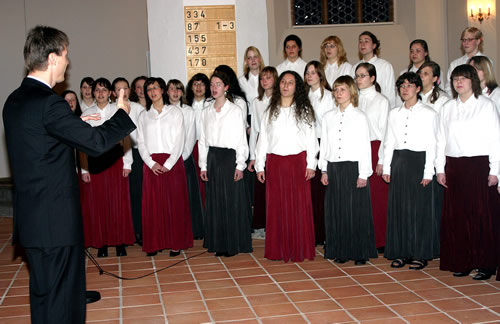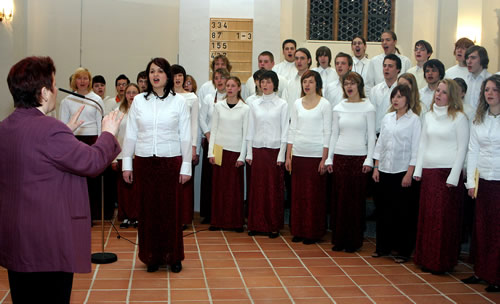

|
|
|
Welcome
|
| Home |
| Preview – Cultural Events |
| Essays, Poetry, Points of View |
| Archives |
| Contact Us |
| Reports
from our Correspondents |
| Institute |
| Educational Tours: We organize performances for you at home and abroad. Just have a look at our offers … here |
|
"What is Culture? This topic can be found ... here!" |
Charity Concert Given by the Choirs of Lessing Grammar School in St. John's Church, Hoyerswerda
Upper Lusatia's
Ambassadors of Song Lovingly restored, the inner city of Hoyerswerda
in Saxony's easternmost region, Upper Lusatia, has become a veritable
treasure chest of cultural history. Bright colours dominate the
historic buildings, with the brightest hues coming from the late
Gothic Johanneskirche or St. John's Church, suffused on the outside
and the inside not only by light, but in April, 2006 also by the
light timbre of a choir that will hardly find its match even in
Germany's celebrated major cities.
Strictly speaking, there were two choirs that taken together encompass almost a third of the entire student body of the Lessing Grammar School so rich in tradition – namely, the girls' choir "Cantemus" and the mixed Youth Choir – which performed on the occasion of a charity concert organized by the Lions Club in the crammed full St. John's Church.
From the very outset, the girls of "Cantemus", numbering about forty, captivated the audience with their spotless intonation, crystal clear transparency and almost ethereal vocal colouring. About half of their contributions were characterized by the English language, both in the religious field – ranging from the Norwegian Egil Hovland's psalm version "O Come, Let Us Sing" to American gospel classics such as "Joshua Fit the Battle of Jericho" and "Ticket to the Kingdom" – and in Thomas Morley's vivacious and amorous madrigals from chivalrous Elizabethan times.
For
all his international orientation, choirmaster Lothar Kusche also
highlighted popular songs from the German regions, including contemporary
scorings such as Heinz Lemmermann's "swinging" version
of "Hab mein Wage vollgelade" and an absolute curiosity
in waltz rhythm, "Die Schwätzer" by Hessian composer
Winfried Siegler-Legel. Between songs, the girls moved swiftly,
orderly and noiselessly into the ideal acoustic position for each
work.
A marvellous thematic unity combined with stylistic diversity was demonstrated by the mixed Youth Choir under the direction of Ilona Seliger, head of the faculty of arts. There was no shortage of young male singers among the approximately seventy voices, which confirms the high regard for vocal music at Lessing Grammar School. At this point, the French language ("Au clair de la lune") and even the Czech language were added with Leoš Janácek's adaptation of two Moravian songs by Antonín Dvorák, pearls of Slavic Romanticism. The Late Renaissance, too, was represented – one rarely hears a performance as brisk as that of Hans Leo Hassler's "Tanzen und Springen". However, a calming influence emanated from the slow marching rhythm of James E. Moore's hymn tune "That We May Be One", a long-time favourite for wedding ceremonies in English-speaking countries.
Quite surprisingly at times, the delicately woven choral sound grew to a lush, rounded opulence that made the church reverberate, almost reminiscent of the mighty vocal tradition of our Slavic neighbours. Thus, Johannes Brahms' "Waldesnacht" suddenly erupted with "the world's loud commotion" ("lauten Weltgewühle"), similar to the cheerful exuberance of Rolf Lukowsky's arrangement of "Horch, was kommt von draußen rein" with pure, infectious joy of singing. The spring concert ended splendidly with spirited piano accompaniment to the notes of Jay Althouse's polyglot, Spanish-Latin song of praise, "Exultate Cantamos Festivo". Subsequently, two cheques were presented to the "Lebenshilfe" (association for the mentally disabled) and to a centre of support for the physically disabled by Lions Club President and City Councillor Hartmut Ackermann.
What is the secret of the high quality and the international reputation of these choirs? Excellent teachers, certainly, and perhaps a continued effect of the Sorbian singing tradition that was cultivated for centuries in Upper Lusatia. Very clearly, it was possible to discern the ideals of the finest and most creative models of music education in the former GDR such as the professors Bimberg and Lukowsky. Equally remarkable in this context is the status of Lessing Grammar School under its long-standing Principal Ortrun Böhme as one of only six grammar schools with "enhanced education in the arts", which includes, in addition to advanced courses in music, experience in orchestral playing, jazz, dance and the theatre.
For a long time, the award-winning choirs of Lessing Grammar School have been going on tour as cultural ambassadors of their region. Far beyond technical perfection, they have achieved a clear cut profile in their style of singing, which represents a distinct counterpoint in voice formation and expression, for example, to the Mediterranean ideal – the pathos and drama of operatic choirs are so remote from their style, that even ritardandi at the end of a piece are employed by Ilona Seliger with the utmost economy. Moreover, what elicits even higher admiration, is that all the choir members have complete command of every note of their programme by heart. In summary – and this makes every support of these young talents by our Network for International Cultural Exchange appear justified – they possess all the qualities among Saxony's top choirs to represent the vocal culture of our country even far beyond the Federal Republic's borders.
Ingo Bathow |
|
Correspondent |
| Always on duty, he is collecting interesting news items for you. |
| Please send us an e-mail if you have an important event or topic on which you would like him to write a report. |
| Impressum |
|
©Network
for International Cultural Exchange
2003-2006 / Upper Lusatia's Ambassadors of Song -Ingo Bathow |

